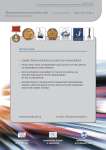Nanotechnologies in Construction: A Scientific Internet-Journal @nanobuild-en
Статьи журнала - Nanotechnologies in Construction: A Scientific Internet-Journal
Все статьи: 572
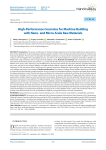
High-Performance Concretes for Machine Building with Nano- and Micro-Scale Raw Materials
Статья научная
Introduction. The unique combination of rheotechnological properties and mechanical performance opens up prospects for the application of self-compacting and high-strength concretes in the manufacturing of base elements for machines and industrial equipment. The processes of adsorption of modern plasticizers on various mineral and polymeric modifiers of concrete mixtures were investigated. The compatibility of nano- and micro-scale mineral additives in composite cementitious binders was determined using calorimetry with an improved semi-adiabatic setup. Materials and methods. The cementitious binders used were CEM 52.5N Portland cement (Asia Cement LLC, Russia) and Nanodur (Germany, Dyckerhoff GmbH); hyperplasticizers included Melflux 1641F, 2651F, 5581F (Germany), PCE TR-6088 (China), Sika ViscoCrete 240 HE Plus and 226-P (Russia); superabsorbent polymer; nano- and micro-scale mineral additives included microsilica MK-85, metacaolin VMK-45, microcalcite MM-315, marshalite Silverbond 15 EW, and ground silica-containing rocks. Selective dissolution, differential thermal analysis, laser granulometry, and semi-adiabatic calorimetry were employed. Results and discussion. The quality of ultrafine mineral additives determines their ability to chemically bind portlandite through pozzolanic activity. Among the investigated additives, microsilica and gaize demonstrated the highest pozzolanic activity. Thermal activation was effective for components consisting of crystalline silica (marshalite, ground quartz sand), resulting in a 25% increase in performance. There was no selective adsorption of hyper plasticizer molecules by superabsorbent modifiers based on sodium polyacrylate compositions. Metakaolin and tremolite exhibited high adsorption to hyper plasticizers among the mineral additives. The rapid evaluation of the influence of formulation factors on the setting of cementitious composites was tested on an improved version of the semi-adiabatic calorimeter. Conclusions. The presence of micro-scale mineral additives based on microsilica in composite cementitious binders enables the development of high-performance concretes adapted for machine building. The study of pozzolanic activity, adsorption capacity, and cumulative heat release curves has indicated the feasibility of replacing microsilica with metacaolin and the potential for its partial blending with finely ground natural gaize. Analysis of the thermal effects accompanying the hydration processes of the "cement-additive-water" system with calorimeters allows us to provide more efficient research on the compatibility of additives in high-performance concrete compositions.
Бесплатно
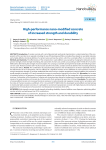
High-performance nano-modified concrete of increased strength and durability
Статья научная
Introduction. To create concrete with a set of physical and mechanical characteristics, a rational selection of the components of the concrete mix is required, including the use of finely dispersed fillers, including those based on recyclable materials, and a highly effective chemical additive of a certain nature and reactive action, which has a complex effect on concrete system. Methods and materials. The effectiveness of the components in used additive was assessed by changing the indicators of compressive strength, tensile strength in bending, the assessment of which was carried out according to GOST 10180-2012 “Concrete. Methods for determining the strength of control samples. For carrying out scientific and experimental studies, the following materials were used: Portland cement CEM I 42.5N; natural sand; fine microsilica; complex chemical additive with increased plasticizing and reactive effects. Results. The combination of polycarboxylate polymers and nanodispersions of silicon hydroxide enhances the effectiveness of each component, which is reflected in a significant increase in the coefficient of crack resistance of concrete at high compressive strength. It has been established that when using a complex nanopolymer chemical additive, the increase in tensile strength in bending is 67% and it exceeds the increase in compressive strength by more than 30%. Discussion. An increase in hydration activity in the presence of a nanopolymer additive has a positive effect on the compaction of the emerging concrete structure. Confirmation of the formation of a dense and strong structure during the hardening of nanomodified concrete is an increase in the water resistance of concrete by 2.5 times and its frost resistance by more than 2.5 times. Conclusion. The advantage of nanomodified concrete is its increased chemical resistance to carbon dioxide and magnesia corrosion and, in accordance with the index of chemical resistance coefficient, CCSт> 0.8, and GOST R 58895-2020, the developed nanomodified concrete belongs to chemically highly resistant concretes. It is advisable to recommend nanopolymer concrete with high physical and mechanical properties for the manufacture of structures for overhead power transmission lines (OPL).
Бесплатно
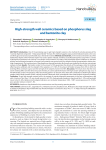
High-strength wall ceramics based on phosphorus slag and bentonite clay
Статья научная
Introduction. One of the promising ways to get high-strength ceramics is the method of semi-dry pressing of the "coarsely dispersed component – finely ground binder" formula. This method suggests using crushed industrial waste as the core, and finely ground nanostructured fusible clay as the binder material. Methods and materials. In the research, bentonite clay of the Darbazinsky deposit of the Turkestan region was used as plastic material, and dense crystallized phosphorus slag which is a waste of phosphorus production was used as a non-plastic coarse material. The study of the prescription factors’ influence on the basic physical and mechanical properties of ceramic wall materials was carried out by the simplex method characterized as lattice planning of experiments. The nanostructure of the phosphorus slag and bentonite clay formula was studied by the electron microscopic analysis method. Results. The binder content in the amount of 25% guarantees the density of the packages, while the sintering effect becomes sufficient and the strength of the samples is 27.1 MPa. If the amount of binder increases from 25% to 40%, the sintering effect continues to grow and the strength of the samples reaches 54.3 MPa. Discussion. The results show that the most active sintering effect and the dense structures forming in coarse-grained formulas with high-calcium phosphorus slag occur at 40–60% binder content. The presence of flux around slag grains in an amount of less than 30% contributes to obtaining less dense samples, with a binder content of 40%, a density increase is observed, which corresponds to the mixed ceramic structures modeling. Conclusion. To get high-strength ceramic bricks, the content of coarsely dispersed components in the form of phosphorus slag with a fraction of less than 1.25 mm should amount to 60–70%, finely ground phosphorus slag should be 5–10%, and bentonite clay is to be 20–30%. Optimum technological indicators are: calcination temperature 1050–1100oC, pressing pressure 20–25 MPa, press powder moisture content 7–8%.
Бесплатно
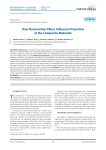
How Nanocarbon Fillers Influence Properties of the Composite Materials
Статья научная
Introduction. Currently the most promising type of repair uses composite materials to fill in fractures or fracture-like defects. In order to be effective, the composite material must possess high fluidity in its liquid state to ensure it can fill the cavity of the defect, adhesion to steel to bond the edges of the crack, and plasticity to compensate for any deformation caused by regular and static loading of the structure. Methods and materials. Composite materials with nanocarbon fillers were studied, including fullerenes, nanotubes, and graphene. The solutions to the problems were obtained using both standard and independently developed methods, statistical data processing techniques, and modern software complexes. Results and discussion. The composite material with a fullerene filler demonstrates a sustainable fluidity in comparison to other studied composites. This allows to recommend such a material for fixing cracks with a slight opening. The composite with a carbon nano tube filler maintains the fluidity at the same level within 35 minutes on average. It can be used as a repair material in cases where the location of the defect does not allow for its sealing to be carried out in a short period of time. Conclusion. The conducted research allows to solve the direct and inverse problem: a) studying properties of a composite material and designing its structure allow to determine, if it fit to certain dimensions of the crack; b) a detected crack with a certain configuration of the cavity can be offered the most suitable properties of the composite by adjusting its content.
Бесплатно
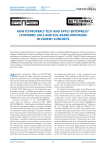
How to properly test and apply BETOPRESS® lyophobic sols and sol-based modifiers in cement concrete
Статья научная
This article provides information in the accessible form about a completely different approach to the testing and application of lyophobic sols and sol modifiers in cement concrete, in contrast to any other chemical additives that are classified as true solutions in liquid form. The criteria outlined in clause 6.11 of GOST 27006-2019 for the selection of compositions produced in laboratory conditions cannot be extended to sols and sol modifiers, which are stabilized colloidal solutions. This specifically pertains to the preparation of concrete mixtures for subsequent testing. GOST 27006-86 was released during a period when all chemical additives used in concrete were solely available in the form of true solutions, comprising fully dissolved molecules and ions resulting from the complete dissolution of all components in water.
Бесплатно
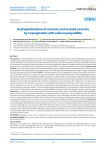
Hydrophobization of concrete and aerated concrete by impregnation with calcium polysulfide
Статья научная
Introduction. A method for protecting concrete and aerated concrete by treatment with a calcium polysulfide-based solution is considered. The solution penetrates into the pores of the materials and, after drying, forms a water-repellent nanoscale layer, protecting the material from water penetration. This ultra-thin layer is formed as a result of the destruction of calcium polysulfide molecules while drying the impregnating solution and gives the material hydrophobic properties. The paper presents research results of the properties and composition of the forming protective layer and its effect on water penetration into the materials. Materials and methods. In the article authors present data on water penetration into the studied concrete and aerated concrete samples, the size and composition of the hydrophobic agent using laser and X-ray diffraction, ultraviolet spectroscopy, as well as using visual research methods, including electron microscopy. Results. It has been revealed that the hydrophobic surface is formed from a mixture of sulfur and calcium carbonate. It is shown that concrete and aerated concrete impregnated with a calcium polysulfide-based solution acquires pronounced water-repellent properties, expressed in contact angles corresponding to superhydrophobic surfaces. The presence of sulfur was established by ultraviolet spectroscopy, and force microscopy showed the formation of nanocomposite particles from sulfur and calcium compounds. X-ray phase analysis showed that the protective layer deposited on the surface of the materials consists of sulfur nanoparticles (65%), as well as nanoparticles of calcium compounds – vaterite (21%) and calcite (13%). Surface treatment of concrete with a sprayer leads to a decrease in water absorption from 5.4% to 3.1%, and in the case of treatment by immersion to a value of 1.5%, while the use of preliminary vacuuming before immersion of the samples allows achieving a water absorption parameter of 0.9%. It is shown that impregnation with preliminary vacuuming leads to water absorption values of less than 1%, which indicates the practical water impermeability of samples of full-scale products (concrete curbs and pipes). Discussion. It is noted that during surface treatment of aerated concrete with a sprayer, a chemically resistant superhydrophobic layer in the form of a nanocomposite is being formed, which penetrates to a depth of 3–3.5 cm, reliably protecting the material from water and chemical penetration. Surface treatment is effective in cases where objects (facades, above-ground structural elements, etc.) are exposed to water in the form of rain. Treatment of concrete products by immersion and immersion treatment with vacuuming can be carried out in harsh cases of constant water exposure (underground utilities, tunnels, manholes). Conclusions. The limitation of water penetration, and in some cases the absence of water in the pores of building materials impregnated with calcium polysulfide, indicate the preservation of substance, since water is a carrier of substances that destroy concrete and aerated concrete. Accordingly, there is no destructive effect from freezing of water in the pores of such materials as a result of the formation of a nano-sized coating of sulfur particles. Comparison of the results for aerated concrete shows that it acquires superhydrophobic properties, which indicates its excellent modification and expands the possibilities of its use. The data observed for concrete products indicate that after treatment with a calcium polysulfide-based solution, they can be used under conditions of long-term and constant exposure to water.
Бесплатно
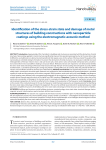
Статья научная
Introduction. Approximately 20% of accidents in buildings and structures are associated with the destruction of metal structures. Nanocoatings applied to metal structures significantly improve their operational properties, but at the same time make it difficult to use traditional non-destructive testing methods that require access to the surface of the base metal. The quality of the nanocoating is controlled during its formation. To prevent the destruction of metal structures, it is necessary to identify structural heterogeneities of the base metal in micro- and sub-micron sizes, which arise in areas of increased mechanical stress concentration and transform into macrodefects leading to structural failure. Methods and tools are required to non-destructively identify the stress-strain state and damage of the base metal structure through the layer of nanocoating. Electromagnetic-acoustical (EMA) transformation, is considered promising for solving this problem. Existing EMA tools do not fully utilize the potential of EMA conversion, have insufficient sensitivity and the lack of informativity. Methods and materials. For experimental research, we selected widely used in construction structures steels. Research was conducted on the interrelationship of structural alterations in standard samples of metals and the parameters of the electro-magnetic (EMA) transducer under static and cyclic loads. Results. Load diagrams of metal samples were obtained, with accompanying photographs of microstructure in control points, along with their frequency models derived through spectral analysis of the signal from EMA transducer. Discussion. Changes in the stress-strain state of the metal and accumulation of damage in its structure result in a complex interrelated set of changes in mechanical, acoustic, and electro-physical properties, all of which are reflected in the changes in the parameters of the frequency model. Conclusion. Based on the results of the conducted research, the use of a frequency model has been proposed as an integral parameter for identifying the stress-strain state and damage of metal in the equipment. The use of an artificial neural network for analyzing frequency model parameters simplifies the process of identifying the stress-strain state and damage of metal structures and increases its reliability.
Бесплатно
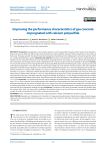
Improving the performance characteristics of gas concrete impregnated with calcium polysulfide
Статья научная
Introduction. Impregnation with a solution based on calcium polysulfide showed excellent results in the hydrophobization of concrete, brick and shell rock due to the formation of a water-repellent coating of sulfur nanoparticles on the surface of their pores. This paper presents the data of studying the properties of aerated concrete, widespread in construction practice, which has a widely developed pore system. Materials and methods. The data on the penetration of water into the studied samples of aerated concrete using the methods of visual examination, including electron microscopy, as well as methods for measuring the water absorption and strength of the samples impregnated with a solution based on calcium polysulfide are presented. Results. It is shown that aerated concrete impregnated with calcium polysulfide, despite the developed pore system, acquires pronounced water-repellent properties. It was found that the optimal processing time is 20 minutes, and the increase in the water-repellent properties of aerated concrete depends on the density of the impregnating solution. As a result of impregnation of aerated concrete by immersion in a solution with a density of 1.16 g/cm3, a decrease in 3.7 times occurs, and when treated with a solution with a density of 1.25 g/cm3, it decreases 6.8 times and becomes equal to 6%. For samples processed with the use of vacuum, in the case of processing a solution with a density of 1.16 g/cm3, water absorption decreases by 7.9 times, and when processing with a solution using vacuum, it decreases 19.8 times, while the compressive strength increases by 1.7 once. Samples of aerated concrete, treated with a polysulfide-based solution with a brush, showed that in this case, water absorption in the sprinkling mode decreases to values of 1.5–2.0%. Discussion. It is noted that during the surface treatment of aerated concrete, a chemically resistant, water-repellent layer 3–3.5 cm thick is formed, which reliably protects the material from the penetration of water and chemicals. The results of the performed experiments give reason to believe that on the surface of the pores of aerated concrete treated with a solution based on calcium polysulfide, as well as on the surface of the pores of previously investigated materials, a nanosized coating is formed of sulfur particles that hydrophobic aerated concrete. Conclusions. Comparison of the results for aerated concrete with excellent data for concrete, brick, shell rock shows that the efficiency for aerated concrete is no less and allows us to recommend the specified solution for long-term protection of the surface of aerated concrete walls
Бесплатно

